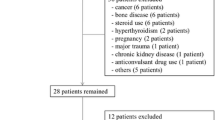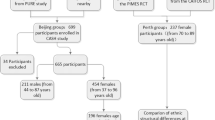Abstract
To determine the relationship between femoral neck geometry and the risk of hip fracture in post-menopausal Caucasian women, we conducted a retrospective study comparing the femoral neck dimensions of 62 hip fracture cases to those of 608 randomly selected controls. Measurements were made from dual-energy X-ray absorptiometry scans (Lunar DPX-L), using the manufacturer’s ruler function, and included: hip axis length (HAL), femoral neck axis length (FNAL), femoral neck width (FNW), femoral shaft width (FSW), medial femoral shaft cortical thickness (FSCTmed), and lateral femoral shaft cortical thickness (FSCTlat). The fracture group was older (median age 78.3 years vs 73.8 years), lighter (median weight 59.9 kg vs 64.5 kg), and, after adjustment for age, taller (mean height 158.7±0.8 cm vs 156.7±0.2 cm) than the controls. Furthermore, bone mineral density was lower in this group (0.682±0.016 g/cm2 vs 0.791±0.006 g/cm2). After adjustment for age, bone mineral content (BMC) or height, hip fracture patients had greater FNW (up to 6.6%) and FSW (up to 6.3%) than did the controls. Each standard deviation increase in FNW and FSW was associated with a 1.7-fold (95% CI 1.3–2.3) and a 2.4-fold (95% CI 1.8–3.2) increase in the fracture risk, respectively. BMC-adjusted FNAL was greater in the fracture group (+2.1%) than in the controls, while the age-adjusted FSCTmed was reduced (−7.2%). There was a trend towards longer HAL (up to 2.1%) after adjustment for age or BMC, and thinner age-adjusted FSCTlat (−1.7%) in fracture patients that did not reach statistical significance. In multivariate analysis, the risk of hip fracture was predicted by the combination of age, FNW, FSW, BMC and FSCTmed. HAL was not analyzed because of the small number of HAL measurements among fracture cases. We conclude that post-menopausal women with hip fractures have wider femoral necks and shafts, thinner femoral cortices and longer femoral neck axis lengths than do women with no fractures. Alteration in hip geometry is associated with the risk of hip fracture.

Similar content being viewed by others
References
Sanders KM, Nicholson GC, Ugoni AM, Pasco JA, Seeman E, Kotowicz MA (1999) Health burden of hip and other fractures in Australia beyond 2000. Projections based on the Geelong Osteoporosis Study. Med J Aust 170:467–470
Cummings SR, Black DM, Nevitt MC, et al (1993) Bone density at various sites for prediction of hip fractures. The Study of Osteoporotic Fractures Research Group. Lancet 341:72–75
Gluer CC, Cummings SR, Pressman A, et al (1994) Prediction of hip fractures from pelvic radiographs: the study of osteoporotic fractures. The Study of Osteoporotic Fractures Research Group. J Bone Miner Res 9:671–677
Faulkner KG, Cummings SR, Black D, Palermo L, Gluer CC, Genant HK (1993) Simple measurement of femoral geometry predicts hip fracture: the study of osteoporotic fractures. J Bone Miner Res 8:1211–1217
Gnudi S, Ripamonti C, Gualtieri G, Malavolta N (1999) Geometry of proximal femur in the prediction of hip fracture in osteoporotic women. Br J Radiol 72:729–733
Crabtree NJ, Kroger H, Martin A, et al (2002) Improving risk assessment: hip geometry, bone mineral distribution and bone strength in hip fracture cases and controls. The EPOS study. European Prospective Osteoporosis Study. Osteoporos Int 13:48–54
Peacock M, Turner CH, Liu G, Manatunga AK, Timmerman L, Johnston CC Jr (1995) Better discrimination of hip fracture using bone density, geometry and architecture. Osteoporos Int 5:167–173
Alonso CG, Curiel MD, Carranza FH, Cano RP, Perez AD (2000) Femoral bone mineral density, neck-shaft angle and mean femoral neck width as predictors of hip fracture in men and women. Multicenter project for research in osteoporosis. Osteoporos Int 11:714–720
Karlsson KM, Sernbo I, Obrant KJ, Redlund-Johnell I, Johnell O (1996) Femoral neck geometry and radiographic signs of osteoporosis as predictors of hip fracture. Bone 18:327–330
Pulkkinen P, Partanen J, Jalovaara P, Jamsa T (2004) Combination of bone mineral density and upper femur geometry improves the prediction of hip fracture. Osteoporos Int 15:274–280
Gnudi S, Ripamonti C, Lisi L, Fini M, Giardino R, Giavaresi G (2002) Proximal femur geometry to detect and distinguish femoral neck fractures from trochanteric fractures in postmenopausal women. Osteoporos Int 13:69–73
Michelotti J, Clark J (1999) Femoral neck length and hip fracture risk. J Bone Miner Res 14:1714–1720
Henry MJ, Pasco JA, Nicholson GC, Seeman E, Kotowicz MA (2000) Prevalence of osteoporosis in Australian women: Geelong Osteoporosis Study. J Clin Densitom 3:261–268
Sanders KM, Seeman E, Ugoni AM, et al (1999) Age- and gender-specific rate of fractures in Australia: a population-based study. Osteoporos Int 10:240–247
Pasco JA, Panahi S, Henry MJ, Seeman E, Nicholson GC, Kotowicz MA (1999) Femoral neck dimensions are unlikely to be associated with age at menarche. Osteoporos Int 9:557–559
Boonen S, Koutri R, Dequeker J, et al (1995) Measurement of femoral geometry in type I and type II osteoporosis: differences in hip axis length consistent with heterogeneity in the pathogenesis of osteoporotic fractures. J Bone Miner Res 10:1908–1912
Duboeuf F, Hans D, Schott AM, et al (1997) Different morphometric and densitometric parameters predict cervical and trochanteric hip fracture: the EPIDOS Study. J Bone Miner Res 12:1895–1902
Bergot C, Bousson V, Meunier A, Laval-Jeantet M, Laredo JD (2002) Hip fracture risk and proximal femur geometry from DXA scans. Osteoporos Int 13:542–550
Center JR, Nguyen TV, Pocock NA, et al (1998) Femoral neck axis length, height loss and risk of hip fracture in males and females. Osteoporos Int 8:75–81
Jorgensen L, Crabtree NJ, Reeve J, Jacobsen BK (2000) Ambulatory level and asymmetrical weight bearing after stroke affects bone loss in the upper and lower part of the femoral neck differently: bone adaptation after decreased mechanical loading. Bone 27:701–707
Acknowledgment
Funding was provided by the National Health & Medical Research Council and the Victorian Health Promotion Foundation.
Author information
Authors and Affiliations
Corresponding author
Additional information
The authors declare no conflicts of interest with regard to this article
Rights and permissions
About this article
Cite this article
El-Kaissi, S., Pasco, J.A., Henry, M.J. et al. Femoral neck geometry and hip fracture risk: the Geelong osteoporosis study. Osteoporos Int 16, 1299–1303 (2005). https://doi.org/10.1007/s00198-005-1988-z
Received:
Accepted:
Published:
Issue Date:
DOI: https://doi.org/10.1007/s00198-005-1988-z




